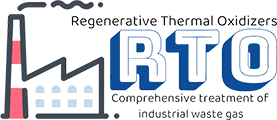What are the initial setup steps for RTO gas treatment?
Regenerative Thermal Oxidizers (RTOs) are widely used for air pollution control in industrial processes. They are effective in removing volatile organic compounds (VOCs) and hazardous air pollutants (HAPs) from industrial exhaust streams. To ensure optimal performance of an RTO, proper setup is crucial. Here are the initial setup steps for RTO gas treatment:
1. Evaluate exhaust streams
The first step in setting up an RTO gas treatment system is to evaluate the exhaust streams. This includes analyzing the composition of the exhaust streams, the flow rate, and the temperature. Based on the analysis, the RTO system can be designed to handle the specific exhaust streams. A well-designed RTO system can ensure high destruction efficiency and low operating costs.
2. Determine the optimal RTO size
The second step is to determine the optimal size of the RTO system. This depends on the volume and composition of the exhaust streams, as well as the required destruction efficiency. An oversized RTO system can lead to unnecessary capital and operating costs, while an undersized system can result in poor performance and regulatory compliance issues.
3. Select appropriate materials of construction
The third step is to select appropriate materials of construction. The materials should be compatible with the composition of the exhaust streams and the operating conditions of the RTO system. Common materials of construction include stainless steel, carbon steel, and ceramic materials.
4. Install the RTO system
The fourth step is to install the RTO system. The installation process should be carried out by a professional team with experience in RTO system installation. The installation process includes setting up the ductwork, fan, and other components of the RTO system.
5. Perform system testing and commissioning
The fifth step is to perform system testing and commissioning. This includes checking the system components for leaks, conducting a performance test, and ensuring compliance with regulatory requirements. The commissioning process should be carried out by a professional team with expertise in RTO system commissioning.
6. Train personnel
The sixth step is to train personnel. Proper training is essential to ensure safe and efficient operation of the RTO system. The training should cover the operation and maintenance of the RTO system, as well as emergency procedures.
7. Conduct periodic maintenance
The seventh step is to conduct periodic maintenance. Regular maintenance is crucial to ensure optimal performance and prolong the lifespan of the RTO system. Maintenance tasks include cleaning the heat exchanger, replacing the ceramic media, and checking the electrical components.
8. Monitor system performance
The eighth step is to monitor system performance. Continuous monitoring of the RTO system is essential to detect any issues and ensure compliance with regulatory requirements. Monitoring parameters include temperature, flow rate, and destruction efficiency. Regular data analysis can help identify opportunities for improvement and optimize the performance of the RTO system.

In conclusion, the initial setup steps for RTO gas treatment are crucial for ensuring optimal performance and compliance with regulatory requirements. Proper evaluation of exhaust streams, sizing of the RTO system, selection of appropriate materials of construction, installation, testing and commissioning, personnel training, periodic maintenance, and system performance monitoring are essential for the success of the RTO gas treatment system.
We are an innovative company dedicated to providing comprehensive solutions for the treatment of volatile organic compounds (VOCs) waste gas and carbon reduction and energy-saving technology for high-end equipment manufacturing. Our team of over 60 R&D technicians, including 3 senior engineers at the researcher level and 16 senior engineers, comes from the Aerospace Liquid Rocket Engine Research Institute (Aerospace Sixth Institute). Our company has four core technologies: thermal energy, combustion, sealing, and automatic control. We have the ability to simulate temperature fields and air flow field simulation modeling and calculation. Additionally, we possess the ability to test the performance of ceramic thermal storage materials, the selection of molecular sieve adsorption materials, and the experimental testing of the high-temperature incineration and oxidation characteristics of VOCs organic matter. We have built an RTO technology research and development center and an exhaust gas carbon reduction engineering technology center in the ancient city of Xi’an, and a 30,000m1^2 production base in Yangling. Our production and sales volume of RTO equipment is far ahead in the world.
Our R&D platform includes:
– High-efficiency combustion control technology testbed
– Molecular sieve adsorption efficiency testbed
– High-efficiency ceramic thermal storage technology testbed
– Ultra-high temperature waste heat recovery testbed
– Gas fluid sealing technology testbed
Our high-efficiency combustion control technology testbed has a combustion efficiency of over 99% and a low-NOx emission level. Our molecular sieve adsorption efficiency testbed can achieve efficient and stable adsorption of VOCs. Our high-efficiency ceramic thermal storage technology testbed can effectively store thermal energy. Our ultra-high temperature waste heat recovery testbed can recover energy from high-temperature waste gas. Lastly, our gas fluid sealing technology testbed can effectively seal high-pressure gas.
We have applied for a total of 68 patents, including 21 invention patents, which cover the core technologies of our company. Among them, we have already been granted 4 invention patents, 41 utility model patents, 6 design patents, and 7 software copyrights.
Our production capacity includes:
– Automatic shot blasting and painting production line for steel plates and profiles
– Manual shot blasting production line
– Dust removal and environmental protection equipment
– Automatic painting room
– Drying room
Our advanced production equipment and management system can meet different customer needs.
We welcome customers to contact us to discuss cooperation opportunities. Our advantages include:
– Advanced technology and equipment
– Comprehensive solutions for VOCs waste gas treatment
– High-quality service
– Experienced technical team
– Global reputation
– Strong production capacity
We look forward to cooperating with you and creating a better future together.
Auteur : Miya
